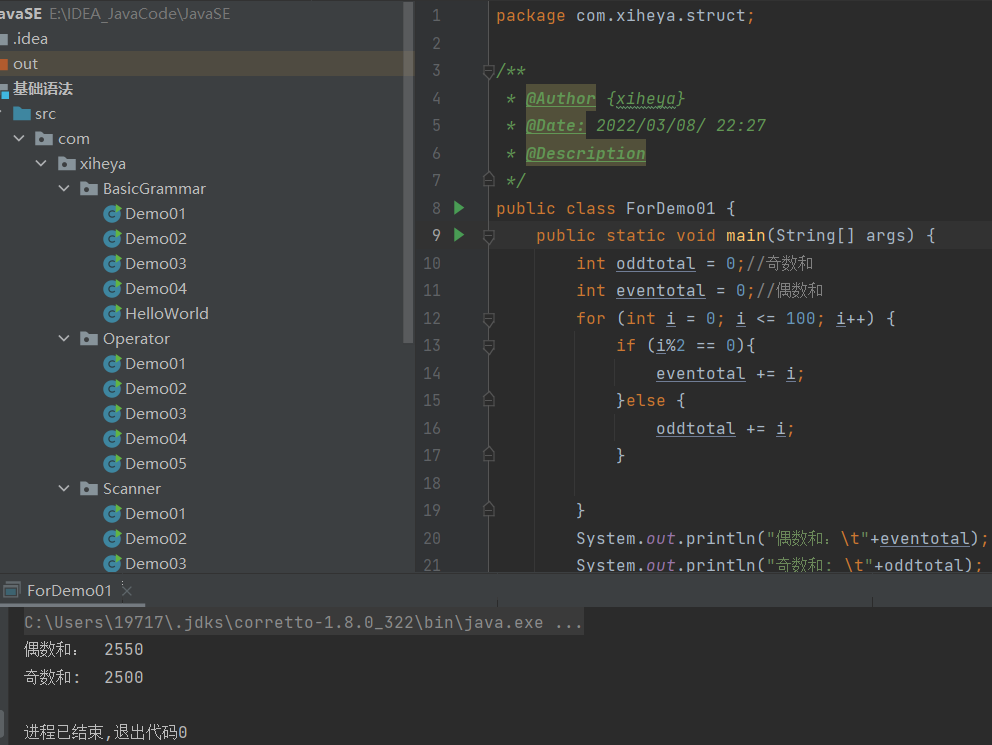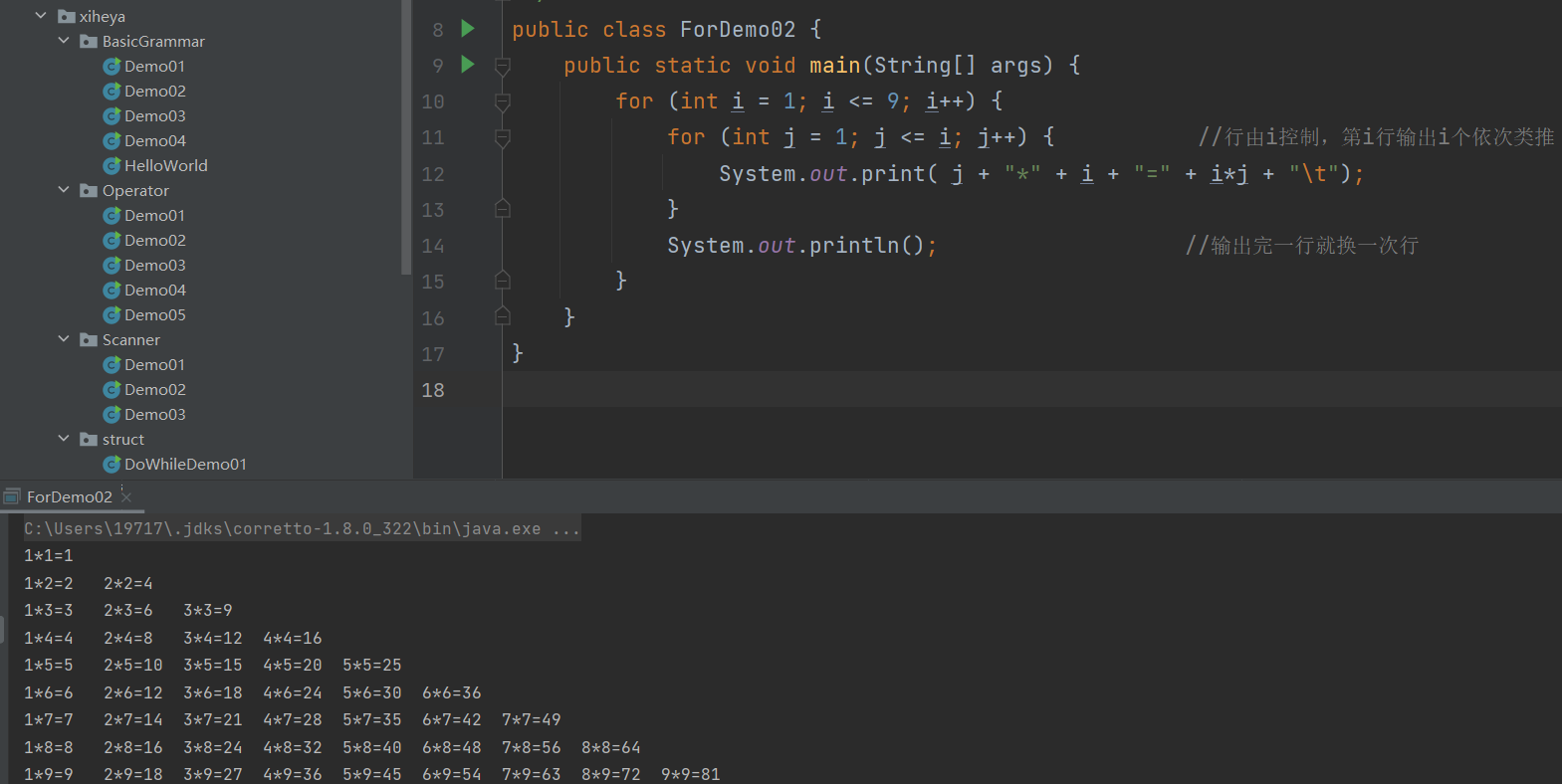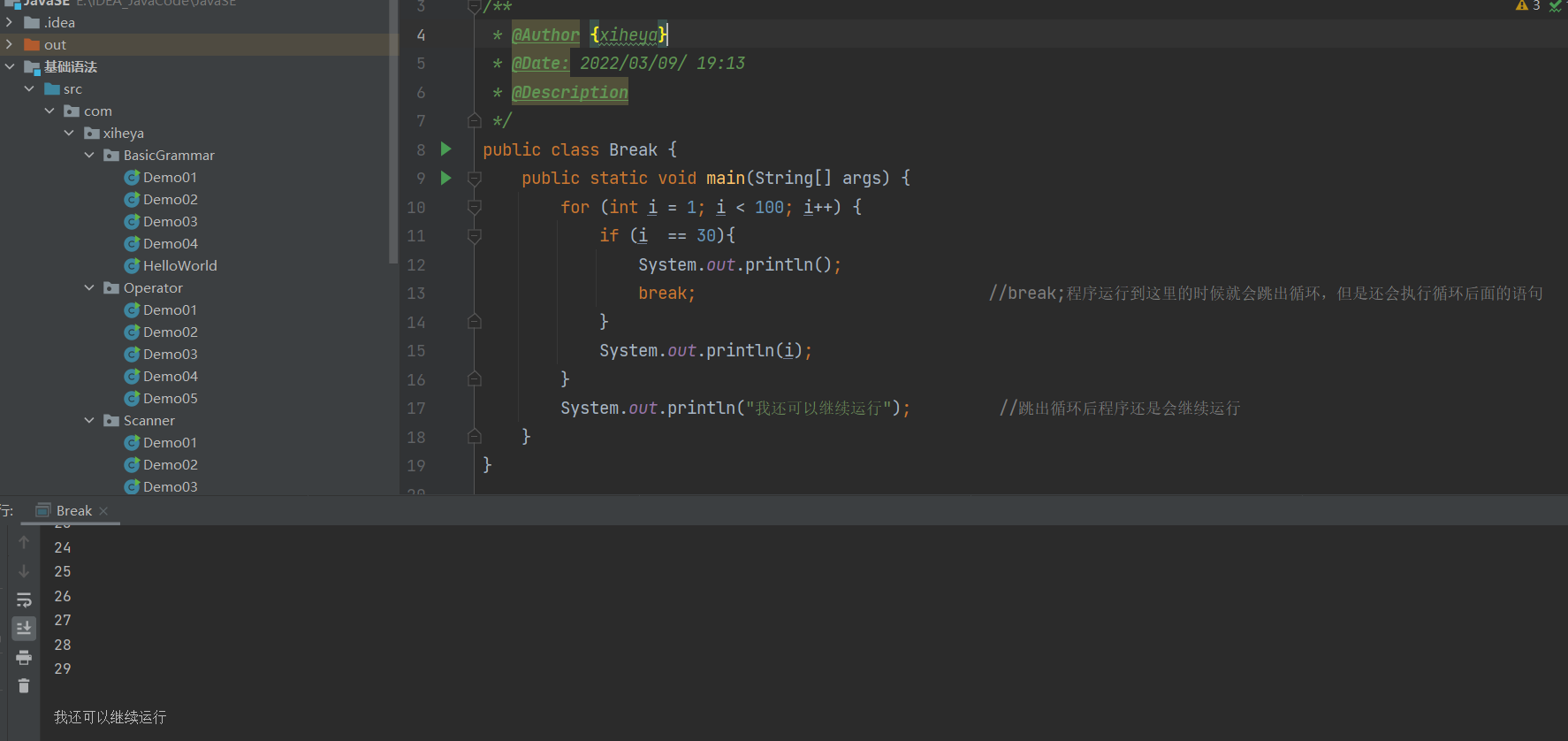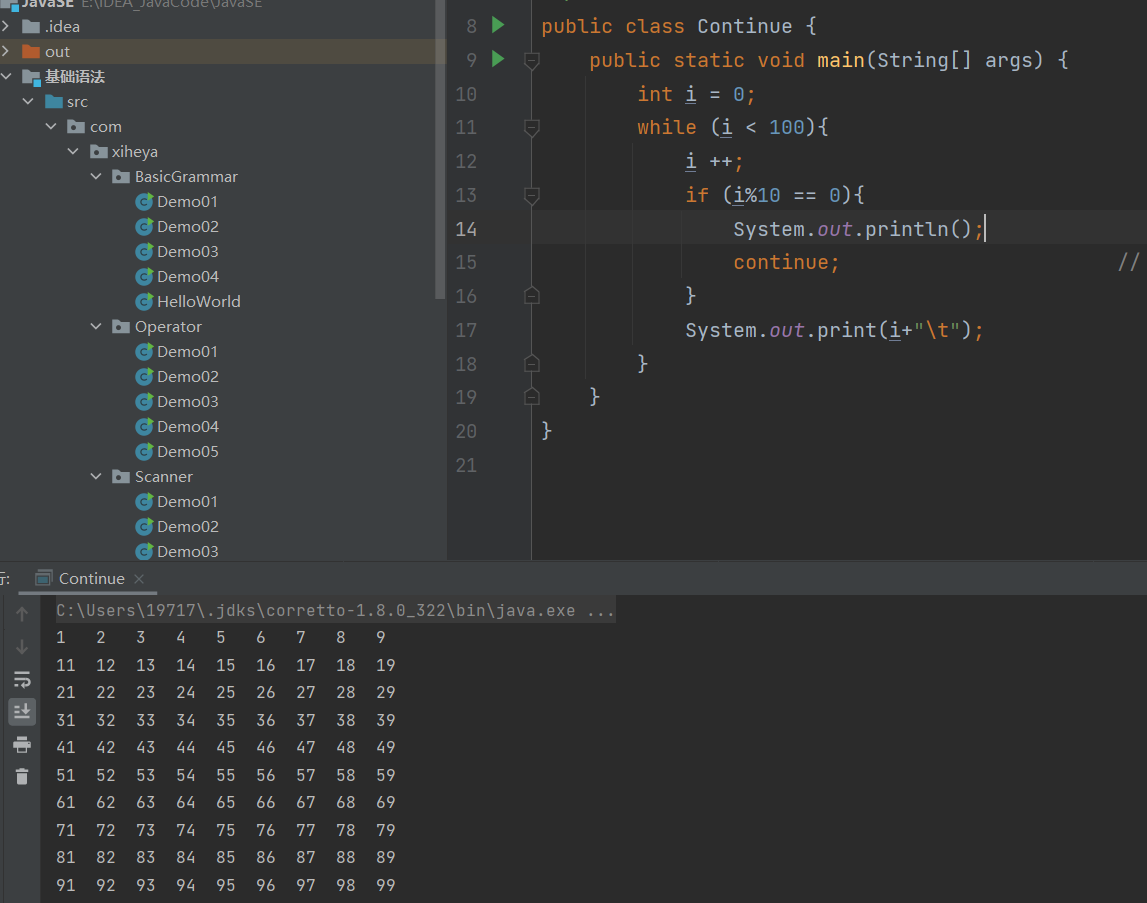循环结构
while 循环
- 只要布尔表达式为true,则循环一直执行下去
- 我们大多数情况下会让循环停止下来,我们需要一个让表达式失效的方式来结束循环
- 少部分情况循环需要一直执行,比如服务器的请求响应监听
- 循环条件一直为true就会造成无限循环【死循环】,正常业务中,应当避免死循环。它会影响程序性能或者造成程序卡死崩溃
设计一个程序计算1+2+3+4+5+……+100;
代码:
1
2
3
4
5
6
7
8
9
10
11
12
13
14
15
16
17
18
19
20
| package com.xiheya.struct;
public class WhileDemo01 {
public static void main(String[] args) {
int i = 0;
int total = 0;
while( i < 100)
{
i++;
total += i ;
}
System.out.println(total);
}
}
|
do …… while循环
- 对于while语句而言,如果不满足条件,则不能进入循环。但有时候我们需要即使不满足条件时 也至少执行一次。
- do ……while循环 和while循环相似,不同的是,多……while循环至少会执行一次。
- 语法
- while和do-While的区别:
- while先判断后执行,dowhile是先执行后判断!
- Do……while总是保证循环体会被至少执行一次!这是他们的主要差别
代码:
1
2
3
4
5
6
7
8
9
10
11
12
13
14
15
16
17
18
19
| package com.xiheya.struct;
public class DoWhileDemo01 {
public static void main(String[] args) {
int i = 0;
int total = 0;
do{
i++;
total += i;
}while(i < 100);
System.out.println(total);
}
}
|
for循环
- 虽然所有循环结构都可以用while或者do……while表示,但Java提供了另一种语句—for循环,使一些循环结构变得更加简单。
- for循环语句是支持迭代的一种通用结构,是最有效,最灵活的循环
- for循环执行的次数在执行前就确定。语法格式如下:
1
2
3
4
| for(初始化; 布尔表达式 ; 更新){
}
|
设计一个程序计算出0-100的奇数和与偶数和
代码:
1
2
3
4
5
6
7
8
9
10
11
12
13
14
15
16
17
18
19
20
21
22
23
24
25
| package com.xiheya.struct;
public class ForDemo01 {
public static void main(String[] args) {
int oddtotal = 0;
int eventotal = 0;
for (int i = 0; i <= 100; i++) {
if (i%2 == 0){
eventotal += i;
}else {
oddtotal += i;
}
}
System.out.println("偶数和:\t"+eventotal);
System.out.println("奇数和: \t"+oddtotal);
}
}
|
运行截图

设计一个程序输出1-1000之间能被5整除的数,每行输出三个
代码:
1
2
3
4
5
6
7
8
9
10
11
12
13
14
15
16
17
18
19
20
21
22
23
24
25
26
27
28
29
30
31
32
33
34
35
36
37
| package com.xiheya.struct;
public class ForDemo01 {
public static void main(String[] args) {
int oddtotal = 0;
int eventotal = 0;
for (int i = 0; i <= 100; i++) {
if (i%2 == 0){
eventotal += i;
}else {
oddtotal += i;
}
}
System.out.println("偶数和:\t"+eventotal);
System.out.println("奇数和: \t"+oddtotal);
for (int i = 0; i <= 1000; i++) {
if ((i%5) == 0){
System.out.print(i+"\t");
}
if (((i+1) % (5*3)) == 0){
System.out.print("\n");
}
}
}
}
|
设计一个程序打印出99乘法表
程序
1
2
3
4
5
6
7
8
9
10
11
12
13
14
15
16
17
18
| package com.xiheya.struct;
public class ForDemo02 {
public static void main(String[] args) {
for (int i = 1; i <= 9; i++) {
for (int j = 1; j <= i; j++) {
System.out.print( j + "*" + i + "=" + i*j + "\t");
}
System.out.println();
}
}
}
|
运行结果

增强for循环
- Java5引入了一种主要用于数组或集合的增强for循环。
- 增强for循环语法格式
- 声明语句:声明新的局部变量,该变量的类型必须和数组元素的类型匹配。其作用域限制在循环语句块,其值与此时数组元素的值相等。
- 表达式:表达式是要访问的数组名,或者是返回值为数组的方法。
代码示例:简单的遍历代码
1
2
3
4
5
6
7
8
9
10
11
12
13
14
15
16
| package com.xiheya.struct;
public class ForDemo03 {
public static void main(String[] args) {
int [] numbers = {10,20,30,40,50};
for (int x : numbers){
System.out.println(x);
};
}
}
|
break 和 continue
- break在任何循环语句的主体部分,均可用break控制循环的流程。break用于强行退出循环,不执行循环中剩余的语句。(break语句也可以在switch语句中使用)
示例:
1
2
3
4
5
6
7
8
9
10
11
12
13
14
15
16
17
18
19
20
| package com.xiheya.struct;
public class Break {
public static void main(String[] args) {
for (int i = 1; i < 100; i++) {
if (i == 30){
System.out.println();
break;
}
System.out.println(i);
}
System.out.println("我还可以继续运行");
}
}
|
输出结果:当i自增到30时,会跳出这个for循环,但是程序还会继续往下运行。

- continue语句用在循环语句体中,用于终止某次循环过程,即跳过循环体中尚未执行的语句,接着进行下一次是否执行循环的判定。
示例
1
2
3
4
5
6
7
8
9
10
11
12
13
14
15
16
17
18
19
20
21
| package com.xiheya.struct;
public class Continue {
public static void main(String[] args) {
int i = 0;
while (i < 100){
i ++;
if (i%10 == 0){
System.out.println();
continue;
}
System.out.print(i+"\t");
}
}
}
|
输出结果:输出时遇到能被10整除的数自动跳过。

- 拓展:关于goto关键字
- goto关键字很早就在程序设计中出现,但仍是Java的一个保留字,并未在语言中得到正式使用;Java没有goto,然而我们在break和continue这两个关键字上,可以看到goto的影子——带标签的break和continue
- 标签是指后面跟一个冒号的标识符,例如:label;
- 对Java来说唯一用到标签的地方是在循环语句之前,而在循环之前设置标签的唯一理由是:我们希望在其中嵌套另一个循环,由于break和continue关键字通常只中断当前循环,但若随同标签使用,他们就会中断到存在标签的地方。
联系
1
2
3
4
5
6
7
| 设计一个程序打印出一个三角形。
**********
**** ****
*** ***
** **
* *
|
1
2
3
4
5
6
7
8
9
10
11
12
13
14
15
16
17
18
19
20
21
22
23
24
| package com.xiheya.struct;
public class TestDemo01 {
public static void main(String[] args) {
for (int i = 1; i <= 5; i++) {
for (int j = 5; j >= i; j--) {
System.out.print("*");
}
for (int k = 1; k < i; k++) {
System.out.print(" ");
}
for (int k = 5; k >= i; k--) {
System.out.print("*");
}
System.out.println();
}
}
}
|






















